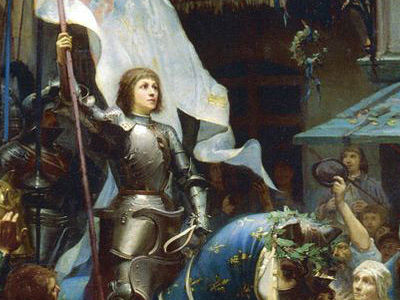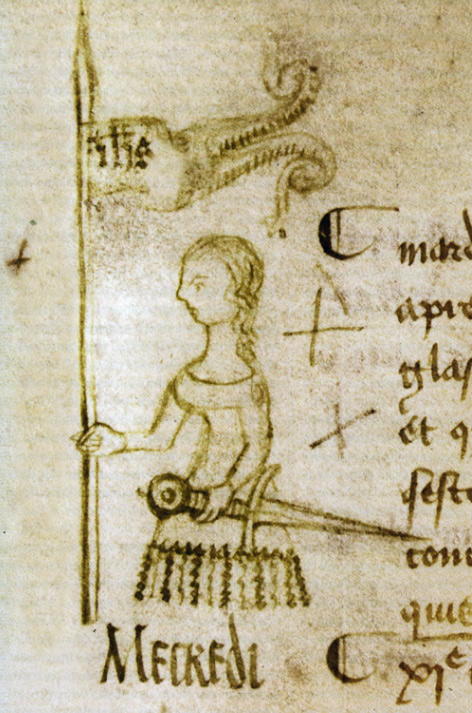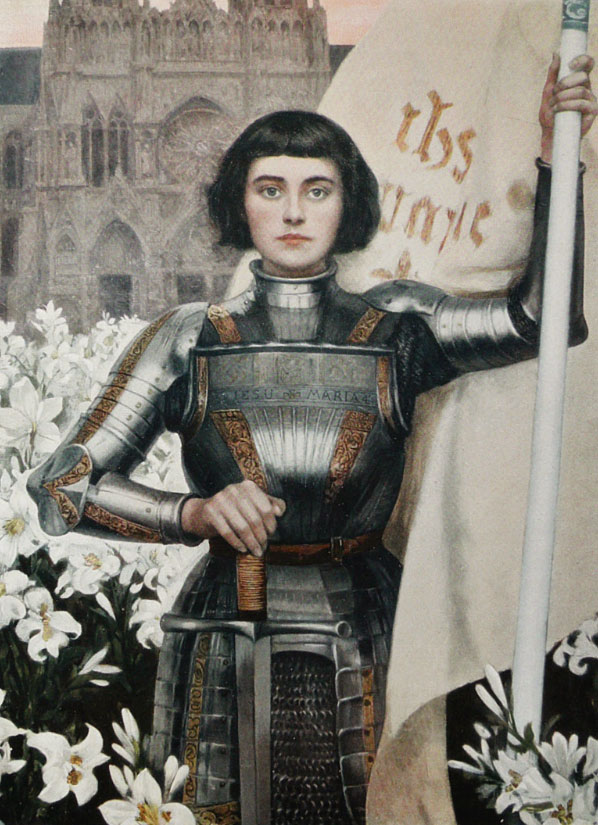Joan of Arc (1412-1431)
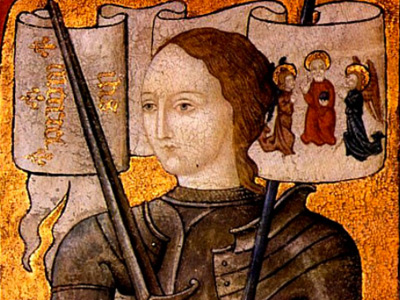
Military Campaigns
The appearance of Joan of Arc at Orléans coincided with a sudden change in the pattern of the siege. During the five months before her arrival, the defenders had attempted only one offensive assault, which had ended in defeat. On 4 May, however, the Armagnacs attacked and captured the outlying fortress of Saint Loup (bastille de Saint-Loup), followed on 5 May by a march to a second fortress called Saint-Jean-le-Blanc, which was found deserted. When English The Kingdom of England was a sovereign state on the island of Great Britain from about 927, when it emerged from various Anglo-Saxon kingdoms, until 1 May 1707, when it united with Scotland to form the Kingdom of Great Britain. The Viking invasions of the 9th century upset the balance of power between the English kingdoms, and native Anglo-Saxon life in general. The English lands were unified in the 10th century in a reconquest completed by King Æthelstan in 927. troops came out to oppose the advance, a rapid cavalry charge drove them back into their fortresses, apparently without a fight. The Armagnacs then attacked and captured an English fortress built around a monastery called Les Augustins. That night, Armagnac troops maintained positions on the south bank of the river before attacking the main English stronghold, called "les Tourelles", on the morning of 7 May. Contemporaries acknowledged Joan as the heroine of the engagement. She was wounded by an arrow between the neck and shoulder while holding her banner in the trench outside les Tourelles, but later returned to encourage a final assault that succeeded in taking the fortress. The English retreated from Orléans the next day, and the siege was over.
The Kingdom of England was a sovereign state on the island of Great Britain from about 927, when it emerged from various Anglo-Saxon kingdoms, until 1 May 1707, when it united with Scotland to form the Kingdom of Great Britain. The Viking invasions of the 9th century upset the balance of power between the English kingdoms, and native Anglo-Saxon life in general. The English lands were unified in the 10th century in a reconquest completed by King Æthelstan in 927. troops came out to oppose the advance, a rapid cavalry charge drove them back into their fortresses, apparently without a fight. The Armagnacs then attacked and captured an English fortress built around a monastery called Les Augustins. That night, Armagnac troops maintained positions on the south bank of the river before attacking the main English stronghold, called "les Tourelles", on the morning of 7 May. Contemporaries acknowledged Joan as the heroine of the engagement. She was wounded by an arrow between the neck and shoulder while holding her banner in the trench outside les Tourelles, but later returned to encourage a final assault that succeeded in taking the fortress. The English retreated from Orléans the next day, and the siege was over.
At Chinon and Poitiers, Joan of Arc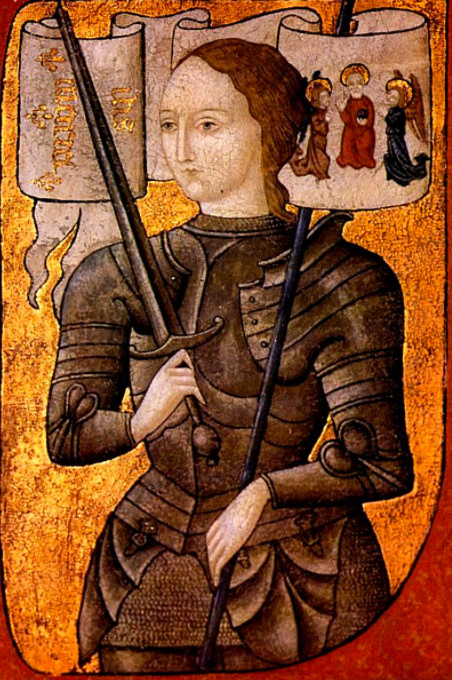 Joan of Arc (1412-1431), is considered a heroine of France for her role during the Lancastrian phase of the Hundred Years' War and was canonized as a Roman Catholic saint. She gained prominence after the siege was lifted only nine days later. This long-awaited event boosted French morale and paved the way for the final French victory. Joan of Arc » had declared that she would provide a sign at Orléans. The lifting of the siege was interpreted by many people to be that sign, and it gained her the support of prominent clergy such as the Archbishop of Embrun and the theologian Jean Gerson, both of whom wrote supportive treatises immediately following this event. To the English, the ability of this peasant girl to defeat their armies was regarded as proof that she was possessed by the Devil; the British medievalist Beverly Boyd noted that this charge was not just propaganda, and was sincerely believed since the idea that God was supporting the French
Joan of Arc (1412-1431), is considered a heroine of France for her role during the Lancastrian phase of the Hundred Years' War and was canonized as a Roman Catholic saint. She gained prominence after the siege was lifted only nine days later. This long-awaited event boosted French morale and paved the way for the final French victory. Joan of Arc » had declared that she would provide a sign at Orléans. The lifting of the siege was interpreted by many people to be that sign, and it gained her the support of prominent clergy such as the Archbishop of Embrun and the theologian Jean Gerson, both of whom wrote supportive treatises immediately following this event. To the English, the ability of this peasant girl to defeat their armies was regarded as proof that she was possessed by the Devil; the British medievalist Beverly Boyd noted that this charge was not just propaganda, and was sincerely believed since the idea that God was supporting the French The Kingdom of France is the historiographical name or umbrella term given to various political entities of France in the medieval and early modern period. It was one of the most powerful states in Europe since the High Middle Ages. It was also an early colonial power, with possessions around the world. Colonial conflicts with Great Britain led to the loss of much of its North American holdings by 1763. The Kingdom of France adopted a written constitution in 1791, but the Kingdom was abolished a year later and replaced with the First French Republic. via Joan was distinctly unappealing to an English audience.
The Kingdom of France is the historiographical name or umbrella term given to various political entities of France in the medieval and early modern period. It was one of the most powerful states in Europe since the High Middle Ages. It was also an early colonial power, with possessions around the world. Colonial conflicts with Great Britain led to the loss of much of its North American holdings by 1763. The Kingdom of France adopted a written constitution in 1791, but the Kingdom was abolished a year later and replaced with the First French Republic. via Joan was distinctly unappealing to an English audience.
The sudden victory at Orléans also led to many proposals for further offensive action. Joan persuaded Charles VII to allow her to accompany the army with Duke John II of Alençon, and she gained royal permission for her plan to recapture nearby bridges along the Loire as a prelude to an advance on Reims and the coronation of Charles VII. This was a bold proposal because Reims was roughly twice as far away as Paris and deep within enemy territory. The English expected an attempt to recapture Paris or an attack on Normandy.
The Duke of Alençon accepted Joan's advice concerning strategy. Other commanders including Jean d'Orléans had been impressed with her performance at Orléans and became her supporters. Alençon credited her with saving his life at Jargeau, where she warned him that a cannon on the walls was about to fire at him. During the same siege she withstood a blow from a stone that hit her helmet while she was near the base of the town's wall. The army took Jargeau on 12 June, Meung-sur-Loire on 15 June, and Beaugency on 17 June.
The English army withdrew from the Loire Valley and headed north on 18 June, joining with an expected unit of reinforcements under the command of Sir John Fastolf. Joan urged the Armagnacs to pursue, and the two armies clashed southwest of the village of Patay. The battle at Patay might be compared to Agincourt in reverse. The French vanguard attacked a unit of English archers who had been placed to block the road. A rout ensued that decimated the main body of the English army and killed or captured most of its commanders. Fastolf escaped with a small band of soldiers and became the scapegoat for the humiliating English defeat. The French suffered minimal losses.
The French army left Gien on 29 June on the march toward Reims and accepted the conditional surrender of the Burgundian-held city of Auxerre on 3 July. Other towns in the army's path returned to French allegiance without resistance. Troyes, the site of the treaty that tried to disinherit Charles VII, was the only one to put up even brief opposition. The army was in short supply of food by the time it reached Troyes. But the army was in luck: a wandering friar named Brother Richard had been preaching about the end of the world at Troyes and convinced local residents to plant beans, a crop with an early harvest. The hungry army arrived as the beans ripened. Troyes capitulated after a bloodless four-day siege.

Entrance of Joan of Arc into Reims in 1429, painting by Jan Matejko

Entrance of Joan of Arc into Reims in 1429, painting by Jan Matejko
( Click image to enlarge)
Reims opened its gates to the army on 16 July 1429. The coronation took place the following morning. Although Joan of Arc and the Duke of Alençon urged a prompt march on Paris, the royal court preferred to negotiate a truce with Duke Philip of Burgundy. The duke violated the purpose of the agreement by using it as a stalling tactic to reinforce the defense of Paris. The French army marched through towns near Paris during the interim and accepted several peaceful surrenders. The Duke of Bedford led an English force and confronted the French army in a standoff at the battle of Montépilloy on 15 August. The French assault at Paris ensued on 8 September. Despite a wound to the leg from a crossbow bolt, Joan remained in the inner trench of Paris until she was carried back to safety by one of the commanders. The following morning the army received a royal order to withdraw. Most historians blame French Grand Chamberlain Georges de la Trémoille for the political blunders that followed the coronation. In October, Joan was with the royal army when it took Saint-Pierre-le-Moûtier, followed by an unsuccessful attempt to take La-Charité-sur-Loire in November and December. On 29 December, Joan and her family were ennobled by Charles VII as a reward for her actions.
HISTORY
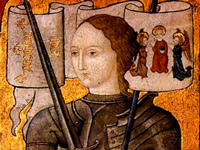
RESOURCES
This article uses material from the Wikipedia article "Joan of Arc (1412-1431)", which is released under the Creative Commons Attribution-Share-Alike License 3.0.
© Stories Preschool. All Rights Reserved.
